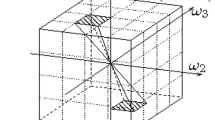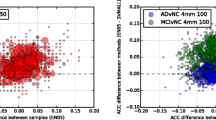Abstract
Background
Patients with mild cognitive impairment (MCI) are a high-risk group for Alzheimer’s disease (AD). Thus, a reliable prediction of the conversion from MCI to AD based on three-dimensional (3D) texture features of MRI images could help doctors in developing effective treatment protocols.
Methods
The 3D texture features of the whole-brain were deduced based on the gray-level co-occurrence matrix. Then, the embedded feature selection method based on least squares loss and within-class scatter (LSWCS) was employed to select the optimal subsets of features that were used for binary classification (AD, MCI_C, MCI_S, normal control in pairs) based on SVM. A tenfold cross validation was repeated ten times for each classification. LASSO, fused_LASSO, and group LASSO are used in feature selection step for comparison.
Results
The accuracy and the selected features are the focus of clinical diagnosis reports, indicating that the feature selection algorithm is effective.




Similar content being viewed by others
References
Brookmeyer R, Johnson E, Zieglergraham K, Arrighi HM. Forecasting the global burden of Alzheimer’s disease. Alzheimers Dement J Alzheimers Assoc. 2007;3(3):186–91.
Fradinger EA, Bitan G. En route to early diagnosis of Alzheimer’s disease—are we there yet? Trends Biotechnol. 2005;23(11):531–3.
Hampel H, Frank R, Broich K, Teipel SJ, Katz RG, Hardy J, Herholz K, Bokde AL, Jessen F, Hoessler YC. Biomarkers for Alzheimer’s disease: academic, industry and regulatory perspectives. Nat Rev Drug Discov. 2010;9(7):560.
Castellano G, Bonilha L, Li L M, et al. Texture analysis of medical images. Clin Radiol. 2004;59(12):1061–9. https://doi.org/10.1016/j.crad.2004.07.008
Harrison L, Dastidar P, Eskola H, et al. Texture analysis on MRI images of non-Hodgkin lymphoma. Comput Biol Med. 2008;38(4):519–24. https://doi.org/10.1016/j.compbiomed.2008.01.016
Jafarikhouzani, K., Elisevich, K., Wasade, V.S.: Contribution of Quantitative Amygdalar MR FLAIR Signal Analysis for Lateralization of Mesial Temporal Lobe Epilepsy. IEEE J Biomed Health Inform PP(99), 1 (2018)
Takahashia T, Murataa T, Naritaa K, Hamada T. Multifractal analysis of deep white matter microstructural changes on MRI in relation to early-stage atherosclerosis. Neuroimage. 2006;32(3):1158–66.
Brun A, Englund E. A white matter disorder in dementia of the Alzheimer type—a pathoanatomical study. Ann Neurol. 1986;19(3):253–62.
Jia J, Peng D, Wang Y. Chinese guidebooks for the diagnosis and treatment of dementia and cognitive impairment(4). Nat Med J China. 2018;15(98):1130–42.
Du Y, Li P, Ji Y. Chinese guidebooks for the diagnosis and treatment of dementia and cognitive impairment (5). Nat Med J China. 2018;17(98):1294–301.
Chu C, Hsu AL, Chou KH, Bandettini P, Lin CP. Does feature selection improve classification accuracy? Impact of sample size and feature selection on classification using anatomical magnetic resonance images. Neuroimage. 2012;60(1):59–70.
Retico A, Bosco P, Cerello P, Fiorina E, Chincarini A, Fantacci ME. Predictive models based on support vector machines: whole-brain versus regional analysis of structural MRI in the Alzheimer’s disease. J Neuroimaging Off J Am Soc Neuroimaging. 2015;25(4):552–63.
Mwangi B, Matthews K, Steele JD. Prediction of illness severity in patients with major depression using structural MR brain scans. J Magn Reson Imaging. 2011;35(1):64–71.
Xin B, Kawahara Y, Wang Y, Gao W. Efficient generalized fused lasso and its application to the diagnosis of Alzheimer’s disease. ACM Trans Intell Syst Technol. 2014;7(4):60.
Wei R, Li C, Noa F, Li L. Prediction of conversion from mild cognitive impairment to Alzheimer’s disease using MRI and structural network features. Front Aging Neurosci. 2016;8:e0115573.
Yan J, Risacher SL, Kim S, Simon JC, Li T, Jing W, Hua W, Huang H, Saykin AJ, Li S. Multimodal neuroimaging predictors for cognitive performance using structured sparse learning international workshop on multimodal brain image analysis. Berlin, Heidelberg: Springer; 2012.
Tibshirani R. Regression Shrinkage and Subset Selection with the Lasso. J R Stat Soc. 1996;58(1): 267–88.
Zhou K, He W, Xu Y, Xiong G, Cai J. Feature selection and transfer learning for Alzheimer’s disease clinical diagnosis. Appl Sci. 2018;8(8):1372. https://doi.org/10.3390/app8081372
Cai J, Hu L, Liu Z, Zhou K, Zhang H. An embedded feature selection and multi-class classification method for detection of the progression from mild cognitive impairment to Alzheimer’s disease. J Med Imag Health Inform. 2020;10(2):370–9. https://doi.org/10.1166/jmihi.2020.2888
Liu J, Yuan L, Ye J. An efficient algorithm for a class of fused lasso problems. 2010
Ryu S, Kwon MJ, Lee S, Yang DW, Kim T, Song I, Yang PS, Kim HJ, Lee AY. Measurement of precuneal and hippocampal volumes using magnetic resonance volumetry in Alzheimer’s disease. J Clin Neurol. 2010;6(4):196.
Ikonomovic MD, Klunk WE, Abrahamson EE, Wuu J, Mathis CA, Scheff SW, Mufson EJ, Dekosky ST. Precuneus amyloid burden is associated with reduced cholinergic activity in Alzheimer disease. Neurology. 2011;77(1):39.
Zhao B, Cai Z. Alzheimer’s Disease. Science Press. 2015
Wang Y, Tian J. Diagnosis and Treatment of Alzheimer’s disease. People’s Medical Publishing House, Beijing. 2009
Bobinski M, Wegiel J, Wisniewski HM, Tarnawski M, Miller DC. Neurofibrillary pathology—correlation with hippocampal formation atrophy in Alzheimer disease. Neurobiol Aging. 1996;17(6):909–19.
Funding
This study was funded by National Natural Science Foundation of China (No. 61802074), Guangdong Medical Scientific Research Foundation, China (No. A2021402), Guangdong Basic and Applied Basic Research Foundation, China (No. 2020A1515010760), Science and Technology Project of Zhanjiang, China (No. 2019A01016), and the Research Fund Project of Guangdong Medical University, China (No. GDMUM2019002).
Author information
Authors and Affiliations
Corresponding authors
Rights and permissions
About this article
Cite this article
Zhou, K., Liu, Z., He, W. et al. Application of 3D Whole-Brain Texture Analysis and the Feature Selection Method Based on within-Class Scatter in the Classification and Diagnosis of Alzheimer’s Disease. Ther Innov Regul Sci 56, 561–571 (2022). https://doi.org/10.1007/s43441-021-00373-x
Received:
Accepted:
Published:
Issue Date:
DOI: https://doi.org/10.1007/s43441-021-00373-x




